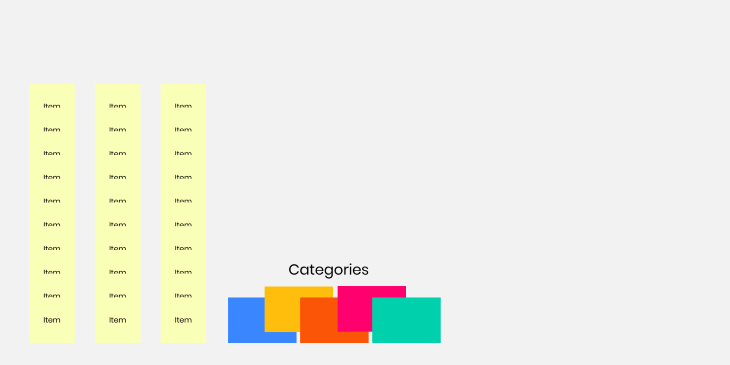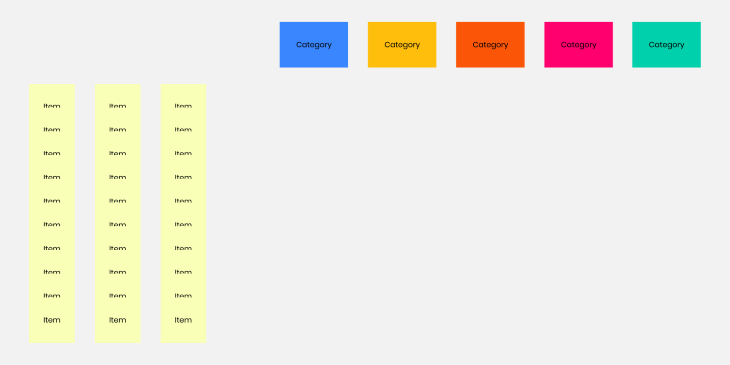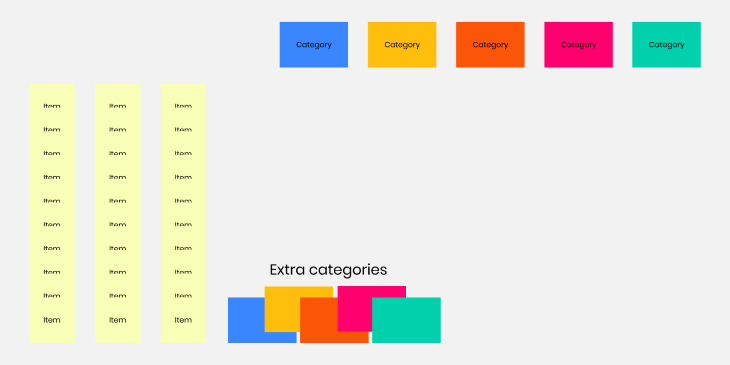When attempting to design or improve information architecture and navigation for a user, we should consider running a card sorting test. Card sorting has existed for many years as a tool to understand the user’s mental model better. It helps UX designers and researchers improve design within apps and websites.
This article will review this method in 360 degrees, find out what its benefits and disadvantages are, discuss when to use it, examine the different types of card sorting, and cover the best practices for card sorting.
- What is card sorting?
- What is information architecture?
- When should you use card sorting?
- Types of card sorting
- Best practices for card sorting
- How to execute effective card sorting
- Online or offline card sorting advice
What is card sorting?
Card sorting is one of the most efficient methods to create a clear information architecture on a website or app for the user. This exercise involves categorizing different items into groups, and it helps you understand how users classify information in their minds so you can improve your website or app.
Let me give you a simple example of how this works. Imagine you have a website that sells furniture — it sells everything from chairs to tables to beds. When a user searches for a new sofa, how will they find it on the web? Is it a sofa for the salon, a white sofa? Do they also want to consider a sofa that extends into a bed at the same time?
As you can see, we need to build navigation and categorize the information in the app in a manner that reflects how users organize information in their minds about the item they search for. Using the card sorting method, we understand better how to organize this information.
What is information architecture?
Information architecture is the practice of organizing, naming, and structuring content to make it easy for users to find and use. As a simple example, a restaurant menu has information architecture, including sections for drinks, wine, starters, etc.
Websites that sell food can organize products and categories to make it easy for users to find what they’re looking for. For example, meat products, milk products, fruits, and vegetables.
Furthermore, information architecture is also used to organize our applications’ menus. A 3D model-making app, for example, can have many options and commands in its menu, and good information architecture will make it easy for the user to find the commands they are looking for.

When should you use card sorting?
UX researchers can run a card sorting exercise when launching a new website to understand how the information can be organized.
You can also do card sorting before adding new sections to your existing website or to test if the current navigation and information architecture work well. This will let you see if your users can easily find the information they need.
Types of card sorting
Three kinds of card sorting exist: open, closed, and hybrid. Let’s examine what each of them can do and how they differ.
Open card sorting
An open card sort involves participants categorizing different topics according to their sense of organization. Typically, designers use open card sorting to understand how users group content.
The participants get some cards with many items, group them, and then name these categories based on their preferences, allowing them to generate ideas and divide the content into their categories.
Once participants have sorted the topics and named the categories, you and the participant can evaluate the structure and discuss why they chose those specific categories.
I used this method in a technical tool for the developers’ project I was involved in. Our page had many items to organize. However, we needed to gain a deep knowledge of categorizing and giving names to them, so we invited users to help us. That way, we learned how to organize the information effectively.

Closed card sorting
Closed card sorting includes presenting cards containing items and category names to the participants, and they need to sort them accordingly.
It is not a way to figure out how users conceptually group topics but merely a way to assess how well the existing categorization structure is.
An example would be a website’s Food category, which includes items such as Fruit, Vegetables, and Snacks. After that, the user could sort cards containing items like bananas, tomatoes, and chips according to their category.

Hybrid card sorting
The hybrid card sorting method combines open and closed card sorting methods, allowing participants to group cards into predefined categories and create their own ones.
You can use this technique if you already have some categories established but are unsure how others should be categorized.

Best practices for card sorting
Number of cards
When conducting a card sorting session, the number of cards needed depends on the study’s goals and the number of items to be sorted.
An ideal number of cards would be between 30 and 50, as this allows for a diverse set of items that can be grouped and labeled in various ways. In addition, the number of items that need to be organized can vary depending on the context and goals of the study.
Write clear topics for accurate sorting
For an accurate card sorting exercise, avoid topics containing similar or identical words. You can use different terminology or provide extra context or information that makes the cards stand out.
To explain it simply, you can use “red apple” and “green pear” instead of “apple” and “pear” to distinguish between the two. If you classify by fruit, apple and pear will be in the same group, but if you add color, they will be in different groups.
You can sometimes explain some topics better by adding images to the cards.
Before you do the session, test it out
Before you do card sorting, test it with 2–3 people so you can see how long it takes to organize everything. In addition, it will help you to find errors in the items you want users to categorize. For instance, you may find that some items are too similar, making it difficult for users to differentiate between them.
Number of participants
According to Nielsen Norman Group, you will get the best results with fifteen participants. With more, you’ll get diminishing returns for each additional user; with fewer, you won’t have enough data to figure out overlapping patterns.
Find the right participants
Participants in a card sorting task should be close to the users. For example, if you are building a website that sells running equipment, you need to find people who run.
Randomize the cards
Randomize the cards before you give them to the user. That way, the user won’t be biased by the order.
Mind the categories
In a closed card sorting exercise, the number of categories presented to participants can vary based on the study’s objectives and the number of items involved. Consequently, the number of categories should be limited to a manageable number that allows for clear grouping and labeling of the items.
When you do open card sorting, it’s a good idea to have the participants categorize first, then give them cards to write their category names on. That way, they can focus on organizing the information first and then give the category a name.
How to execute effective card sorting
The following steps will help you conduct a successful card sorting session.
Find card sorting participants
You can recruit participants for a card sorting study in different ways. Social media and forums are effective places to look for potential participants. Create a post or a survey on different social media sites to attract participants who fit your target audience.
If the product is already available, you can contact the customer service department to get in touch with potential participants. As a result, you can reach out to those who have already used your product or service and may be more interested in participating.
Get in touch with potential participants
Send an email to potential participants that includes clear and transparent information about who you are and how you obtained their email address. Tell them what the study is about and how they can help. By doing this, you can build trust and increase the chances of them participating in the study.
After contacting potential participants, let them know when you’d like the session to occur. In this way, they will be able to plan accordingly and ensure they are available to participate. Be flexible when setting a time to accommodate the participants’ schedules.
If the card sorting session is going to be held online, send an invitation to the online tool and tell everyone how to use it. If the session is offline, send participants site directions and other necessary information so they can find the site easily.
Planning for smooth execution
It’s a smart idea to invite someone else to the session, so you can have a notetaker and someone who will help if needed. This person can help you organize the session and ensure it runs smoothly.
If it’s an online session, ensure the cards are organized well within the online tool so participants can understand the exercise quickly.
Set up the room properly if you’re hosting a meeting on-site. It’s a good idea to write and sort all the physical cards before and have all the materials ready. By doing so, you will save time during the meeting.
To simplify the process of open card sorting, prepare colored blank cards for the user to write the categories on. Colors help users separate categories more easily.
Before starting the task
Before starting the exercise, explain how it will work and why the participants’ contribution is valuable. It’s important to explain to them that any answer is OK and that the goal is to understand better how to organize the data. Ask them to speak aloud. It’ll give you an idea of how they think and why they label and categorize the cards the way they do.
For an unmoderated session, you can add explanations to the board. This will make it easier for participants to understand. Also, you can record a video to make it more dynamic.
It’s also important to let participants ask questions before the session begins to ensure they understand and feel comfortable with the task.
Discussions can take place during the meeting
While the participants sort cards, listen to them and watch how they organize the information. You can help them when needed, but remember not to influence their decisions. As a result, you’ll be able to make sure the instructions are clear and start getting valuable insights.
When they’re done, you can talk to them and ask them why they’ve organized the cards the way they did. You’ll get a better understanding of how they think about the information. This conversation has a lot of value, and you will likely find more than one valuable insight from it.
Be aware that in unmoderated sessions, you won’t be able to have this conversation, and you won’t be able to get the info since the participants are working alone.
Before closing the session
Upon completing the card sorting exercise, thank the participant. Let them know that the insights gained from the session will be used to improve the product experience. This will demonstrate to them that their contributions are appreciated.
In the case of an offline card sorting session, remember to take a picture of the card organization so you can digitize the information and analyze it more easily.
Analyze your card sorting results
After conducting a card sorting exercise, analyze the data to gain insights into the user’s mental model. Finding common categories and relationships between the different cards from the entire group of participants’ results will help you determine the most effective way to organize the data.
Remember that you can also learn much from the user’s comments and observations you make during the session. These insights will give you valuable context and help you better understand why the participants are thinking in such a way.
Using a spreadsheet app, you can organize the information more accurately and analyze the data more efficiently.
When you use a specific tool for card sorting, you may find that the software has advanced data analysis features. These features can save you time and help you quickly identify patterns and trends. If you want to test some tools with advanced data analysis features, you can look at OptimalSort, UXtweak, and UserZoom.
After analyzing the data, it is important to share your findings with your stakeholders and team. In this way, everyone will clearly understand what insights have been gained and how they can be used to improve the navigation and information architecture of the website or app.
Online or offline sessions are both possible
Online or offline: the main idea will be the same in both, but there will be some differences due to the medium.
Tips for online card sorting
- Before the session, email participants to confirm they can access the app
- Ensure that you and your participants have a stable internet connection
- Whenever you speak with someone from a different time zone, ensure both talk about the same time zone. After all, you don’t want to wake up at 3 a.m. to make the session
- Digital tools allow you to organize information quickly, and many apps offer CSV export options
- With an online tool, you can conduct unmoderated sessions. This means that you won’t have to be present at the same time as the participants. This is useful when there is a significant time difference. An unmoderated session has the disadvantage that the researcher cannot ask participants about their categorization
- If you choose a tool with a free plan, you can save money to help you; here is a list of tools with free plans: Miro, OptimalSort, Mural, UXtweak, and Proven by Users.
Tips for offline card sorting
- You can write the items on simple paper, but it’s better to write them on reclyclable cartons. Thus, you will be able to reuse them and people will feel better when using them
- The items can be written by hand on the cards, but printing them will ensure that the text is clear
- If your card sorting is conducted at a computer lab, it is important that you provide participants with clear instructions on how to get to the site so that people can easily find it
- Ensure the room is at an acceptable temperature, and provide the participants with a bottle of water
- You should also ensure that people have enough space to organize the cards, such as a large table
- As soon as the session ends, take a clear picture of the order. It is a good idea to add the participant’s name to the image, as well as more information like the date. It is important to remember that the downside to conducting offline sessions is that you will have to digitize everything once the session ends
Conclusion
A card sorting method is an easy way to understand how to arrange the information on a website or an application to make it easier for users to find what they’re looking for. The method is simple and involves organizing cards into categories and can be applied both before and after the product is launched.
I experienced the effectiveness of this method myself when I worked on a technical product for developers, as I mentioned in the article. I organized the information architecture in a menu, but I found it lacking.
After I carried out the card sorting task and organized the findings, I made many changes because my understanding of information architecture differed from that of the users.
From this experience, I learned an important lesson about information architecture: it is always better to sort cards before organizing information, especially if I don’t control the domain well.
Because of this, I recommend you take a look at the card sorting method and the different types I showed you in the article (open, closed, or hybrid).
There are some tools that you can use that are free and that are easy to use when you need to make a sorting test, regardless of whether it is moderated or unmoderated.
Besides doing it online, you can also do the task onsite. Remember that preparation varies, and offering food or drinks is always a good idea. After all, nothing makes a job easier than a few snacks and a cup of coffee!
So after you have gained all the information about card sorting, now is your time to apply it to your work process. 
Featured image source: IconScout
The post Open vs. closed vs. hybrid card sorting for UX research appeared first on LogRocket Blog.
from LogRocket Blog https://ift.tt/ZzuRtWN
Gain $200 in a week
via Read more



